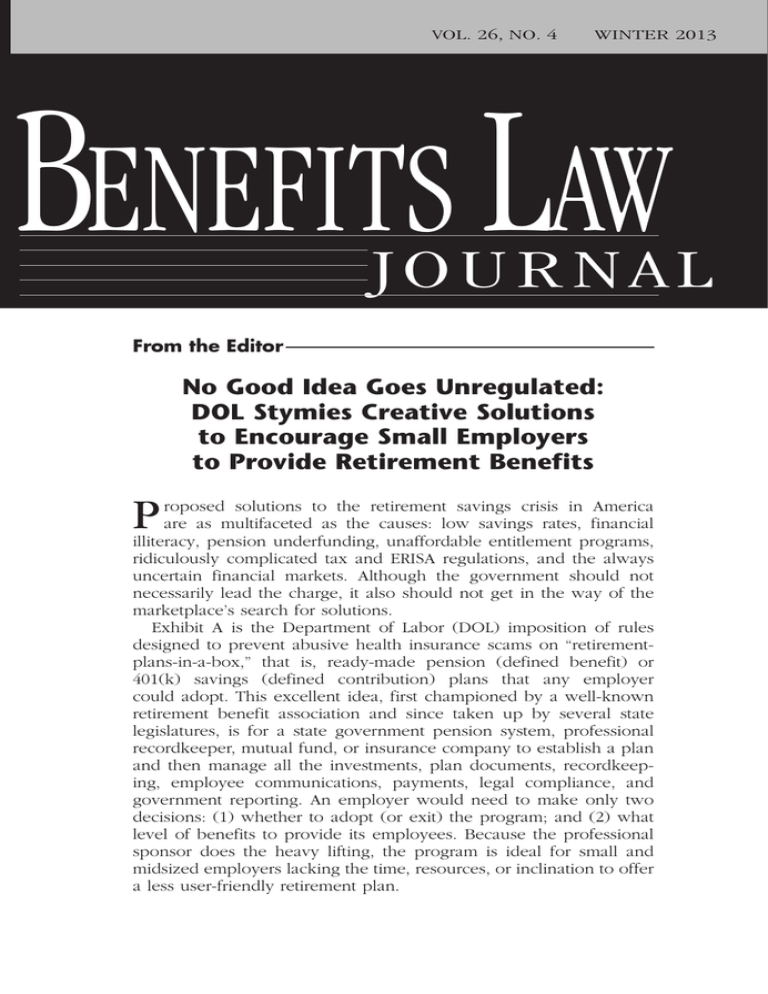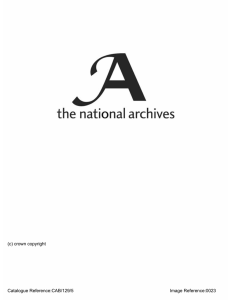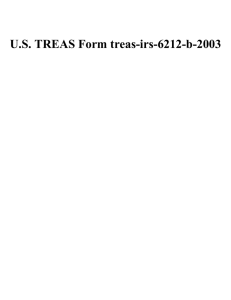
VOL. 26, NO. 4
WINTER 2013
BENEFITS LAW
JOURNAL
From the Editor
No Good Idea Goes Unregulated:
DOL Stymies Creative Solutions
to Encourage Small Employers
to Provide Retirement Benefits
P
roposed solutions to the retirement savings crisis in America
are as multifaceted as the causes: low savings rates, financial
illiteracy, pension underfunding, unaffordable entitlement programs,
ridiculously complicated tax and ERISA regulations, and the always
uncertain financial markets. Although the government should not
necessarily lead the charge, it also should not get in the way of the
marketplace’s search for solutions.
Exhibit A is the Department of Labor (DOL) imposition of rules
designed to prevent abusive health insurance scams on “retirementplans-in-a-box,” that is, ready-made pension (defined benefit) or
401(k) savings (defined contribution) plans that any employer
could adopt. This excellent idea, first championed by a well-known
retirement benefit association and since taken up by several state
legislatures, is for a state government pension system, professional
recordkeeper, mutual fund, or insurance company to establish a plan
and then manage all the investments, plan documents, recordkeeping, employee communications, payments, legal compliance, and
government reporting. An employer would need to make only two
decisions: (1) whether to adopt (or exit) the program; and (2) what
level of benefits to provide its employees. Because the professional
sponsor does the heavy lifting, the program is ideal for small and
midsized employers lacking the time, resources, or inclination to offer
a less user-friendly retirement plan.
From the Editor
For the retirement-plan-in-a-box idea to be attractive, it must be
relatively inexpensive and simple for both the sponsor and adopting
employers to administer. Computers and smart design can take care
of many of the logistical issues. But to succeed, it also needs to be
regulated for Internal Revenue Code and ERISA purposes as a single
“multiple-employer plan,” rather than a thousand, separate miniplans, one for each employer. If it’s not a single plan, the retirementplan-in-box idea adds little, if anything.
There are multiple regulatory advantages to being treated as a single plan. Only one independent accounting audit would be required
(and not thousands of mini-audits) and one IRS Form 5500 Annual
filing (ditto). That may not sound like much of a difference, but those
kinds of regulatory hurdles add an extra layer of costs, hassles, and
concerns to make many turnkey programs undesirable. Significantly,
single multiple-employer plans also enjoy ERISA preemption of state
laws and, if tax-qualified, exemption from the securities laws that
could otherwise treat the program as a “security” or “regulated investment company.”
The IRS, bless its bureaucratic heart, is apparently satisfied that
such a concept should be considered as a single plan. The regulations
simply and reasonably state that a plan whose assets are combined in
one pool, without any employer-by-employer segregation, is a single
plan. In other words, when all participants eat out of the same pot,
it’s a single plan.
Unfortunately, the DOL is not as amenable and has put up a
roadblock against single multiple-employer plans. (Advisory Opinion
2012-04A, May 25, 2012). According to the Department, unrelated
employers can maintain a single plan only if they “are tied together”
by “genuine economic or representational interests.” Whether a group
of employers is sufficiently tied requires a subjective and uncertain
factual analysis. However, simply having the common goal of wanting to offer their employees decent retirement benefits isn’t enough
of a tie-in for the DOL. So the plumbing supply businesses of Arizona
or the medical marijuana dispensers of California can have their
own retirement program—and their employees will somehow be
adequately protected without the added layers of regulation—but not
so for a group of unrelated employers that want to do the right thing
by adopting a retirement-plan-in-a-box.
The DOL’s “affinity group” requirement for single plan status is not
supported by the ERISA definitions of “plan,” “employer,” “employee,”
and “multiple-employer plan.” To be fair, the DOL’s position is not
without precedent. In the past, shady (or worse) organizations have
promoted multiple employer welfare arrangements (MEWAs) as a way
to provide self-insured health benefits to employer groups. Some of
BENEFITS LAW JOURNAL
2
VOL. 26, NO. 4, WINTER 2013
From the Editor
those promoters used ERISA’s preemption of state insurance laws to
escape regulation and run their MEWAs on a less than sound actuarial
basis, sometimes going broke and leaving employees’ health bills
unpaid. The DOL acted to slow the adoption of these plans by essentially inventing the business tie-in requirement. Thankfully, Congress
largely killed off these schemes by amending ERISA in 1983 to require
that most MEWAs comply with both ERISA and state insurance law.
But a retirement plan is not a medical insurance program (do I really
need to say this?), and there is no reason to apply the affinity rule to
retirement plans that do not pose a similar risk of abuse.
The DOL is possibly not the only pension pooper. It’s not clear,
but the Securities and Exchange Commission (SEC) has made noises
that a single multiple-employer plan could be considered an “investment company” or a “security.” The securities laws make clear that a
qualified single-employer plan under the tax rules is exempt from registration under the 1933 and 1940 Acts. However, in a few no-action
letters, the SEC has observed that it need not follow the IRS approach
to what is a single plan. There is no statutory support for the SEC to
ignore the IRS and, significantly, the SEC has never acted contrary to
the IRS standard. Still, the SEC should recognize that the IRS knows
pensions better than it does and follow the IRS’s lead.
There are a lot of smart, knowledgeable, and concerned folks in
the retirement community seeking a way to bring the multitude of
American nonsavers and undersavers into the pension tent. It remains
to be seen which ideas will work, but regulators need to give them a
chance. Past cases of scurrilous health plans should not be used as a
reason to impede a state government pension system or an insurance
company from offering a turnkey retirement plan that would allow
unrelated employers to better prepare their employees for retirement.
The ERISA fiduciary and funding rules already provide the needed
regulatory protections.
The DOL should embrace single multiple-employer plans and
abandon the affinity group requirement. A change of heart by officials
would give a creative new idea a chance, potentially expanding the
universe of retirement plans, especially for employees of small and
midsize businesses. The federal government should give retirementplans-in-a-box and other creative solutions to the savings crisis a
chance to succeed.
David E. Morse
Editor-in-Chief
K & L Gates LLP
New York, NY
BENEFITS LAW JOURNAL
3
VOL. 26, NO. 4, WINTER 2013
Copyright © 2013 CCH Incorporated. All Rights Reserved.
Reprinted from Benefits Law Journal Winter 2013, Volume 26,
Number 4, pages 1–3, with permission from Aspen Publishers,
Wolters Kluwer Law & Business, New York, NY, 1-800-638-8437,
www.aspenpublishers.com



